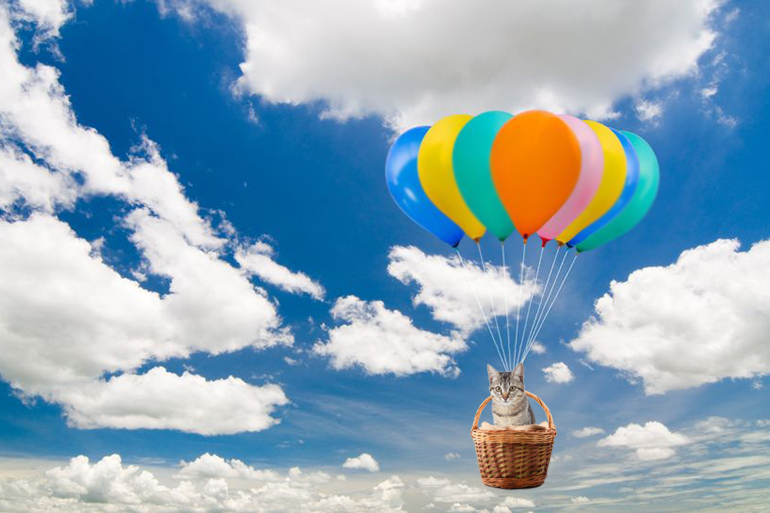Say Goodbye: After 44 Years, 2019 Hamptons Cat Float Might Have Been the Last

Nearly 900 vans and trailers arrived last Friday afternoon at the East Hampton Airport to attend the 44th annual Hamptons Cat Float. Inside were approximately 4,000 excited participants with their 900 cats, franks and burgers, beer coolers, BB guns, helium balloons, binoculars, blankets, folding chairs and barbecue grills and the obligatory boom box radios unique to this event. Friends were made. Dinners were cooked up. Then everyone, excited about what was to come, tried to get some sleep before getting up at the crack of dawn on Saturday.
The first Hamptons Cat Float took place in 1975, when farmer Ezekiel Brown and some of his friends launched their cats over the Brown potato field in Sagaponack. The animals, suspended from helium balloons, seemed to enjoy it. In recent years, the Cat Float has moved from the farm to the airport. It takes place on the first sunny Saturday after the Sag Harbor HarborFrost, which happened this year on February 23. Obligingly, the airport shuts down at noon on Friday, when the first trailers arrive and stays shut until Sunday morning.
RELATED: Hamptons Police Assist as Cats Descend from Sky
Saturday is quite the day. On that morning at 7 a.m., just after sunrise, the Cat Float begins as a salute cannon atop the airport terminal is fired. With that, each cat, in colorful silk ribbon harness, is attached to the end of a rope attached to a helium balloon to be launched off to wherever the winds might take them. This year’s event had the largest turnout ever, probably because this year’s Cat Float might prove to be its last.
This reporter walked in the pre-dawn stillness along the rows of vans and SUVs parked alongside Runway 52 an hour before the cannon shot. It was 48°, with wind gusts of seven miles an hour. I spoke to some of the cat floaters whose doors were open with their lights on inside at that hour.
“It’s a sad day for cat floaters,” said Barbara Renfrew of Casper, Wyoming, who along with her husband came out onto the tarmac to talk to me. Both were in their 60s. “As we do every year, we drove our trailer all the way to attend this event, which we love so. It’s a three-day drive. If they shut it down, so be it, but it will hurt a lot of cat floaters. And a lot who are not cat floaters.”
“This is what’s wrong with America,” her husband, Cal, commented.
Their gray tabby, Hector, appeared at the trailer door to see what was going on and slunk around sadly in the doorway. Cats have great instincts, and even when they are excited and happy for their upcoming flights, swishing their tails back and forth, they know when things are going wrong.
We spoke with Allison Bankovitz and her husband, Theo, retirees in from Lake Havasu, New Mexico. They were eating breakfast inside their trailer, but with the door open. Their cat was having his breakfast, too, right on the table with them. I wasn’t invited in, but they talked to me as I stood in their doorway.
“We won one of the First Prizes seven years ago,” Allison said.
“What was it?”
“A silver cup. I still have it. Only 10 people got silver cups at the awards ceremony.”
“We’ll do it again,” her husband chimed in. He was softly scratching their cat’s back as he ate.
Forty-five minutes before the cannon shot, we were up in the airport tower with Airport Director Willis Claiborne.
“The aircraft owners don’t like it,” he said. “But they understand. It’s been going on since 1975, after all. You can’t stop a tradition such as this. And it’s just one weekend.”
“But now the Town has banned helium balloons,” I said. “It’s a decision to save the environment. No more party balloons can be released above the Town.”
“Well, that will do it,” said Claiborne with a sigh. “It survived objections from environmentalists, it survived objections from the FAA, from people living near the airport, from the ASPCA. To tell the truth, I’ve liked this event very much.”
The sun peeked over the horizon at 6:40 a.m., bathing the entire scene in a sharp morning light. Twenty minutes to go. What a scene. The trailers were side-by-side for the entire mile of Runway 52. The helium balloons, all 900 of them, floated 10 feet up in a long line on the runway, held down by ropes whose ends were under the identical Cat Float bricks that everyone had been issued. Smoke from the morning bacon and sausages on the barbecues wafted into the air on the slightest breeze.
Off in the distance, along the wire fence that borders the airport, the Army marksmen, six of them, were now out of their vehicles and into their sharpshooter positions. Those floating cat balloons that might go over the fence and above the trees off the airport property without being brought down by the entrants with their BB guns would be dealt with by a single, accurate marksman’s shot. Overhead, circling, was the spotter plane to guide the marksmen, and also to shoo away any aircraft approaching the airport who, in spite of all the publicity, were unaware of the temporary closing.
With 10 minutes to go, the entrants emerged from their trailers, shouting and cheering and carrying their cats swishing their tails, now in their silk ribbon harnesses sporting the names of the owners and the phone numbers to call—written in magic marker—should the balloons get away, which has happened before. The clicking sound of so many cat harnesses getting secured to the ropes was audible, even from this distance. The cats love the launch. Maybe not the first time—for the newbies, anyway—but as soon as they are up, they love floating along, looking at other cats and looking down, and from then on it’s just eagerness once a year. And wherever they are around the country, they sense when that time approaches. Really.
A loudspeaker in the tower counts down the time. FIVE, FOUR, THREE, TWO, ONE… And then kaboom, the cannon is fired, a single shot, the entrants lift the bricks and off the cats go.
Have you ever been to this and seen this great army of cats, floating up into the sky above East Hampton Airport beneath their colorful helium balloons? Four thousand people roar their approval, and in the swirling wind above the runway the helium balloons float this way and that, occasionally causing two cats to bump, emitting audible purrs.
The cats drifted around up there for an hour, the required time, and then, one by one, their balloons were hit by gunfire—no cat has ever been injured, of course—and with that the cats floated back down to the airport property, with the exception of, as happens every year, a few that float off to God knows where.
Claiborne tells me about it as he watches one balloon become a speck and disappear over Sagaponack.
“Used to be there were a dozen or more that came back down elsewhere, in people’s backyards, in trees, down by the beach. The owners would be just a phone call away. New friendships were made. The whole community loved being part of this.”
“We did lose a few,” I said.
“Yes, we did. Averaged maybe two a year. But we just considered that the cat found a new home. Had to be. No cat ever was seen flying over the ocean. So, yes, there were tears. But owners were always philosophical. They’d recover, and there were new cats.”
“And this might be the last one.”
“Yes,” Claiborne said. “I think the helium balloon ban makes sense, but that they denied a requested exception for the Cat Float could only be explained by the changing times. There are so many summer people now who just like the privacy of being in their mansions and don’t want some cat under a balloon floating down on their tennis court.”
The awards ceremony took place in the airport terminal as the sun began to set at 7 p.m., and most people stayed for it. Hot apple cider was served. The engraved silver cups were given out, the winning cats held aloft. There were more cheers, but also some tears.
And then, after that, final family meals were held along the runway—runway lights were turned on as a courtesy—and soon after that, as night fell, the great caravan of trailers set out through the entry gate and out onto Daniels Hole Road for the trip home.
(With thanks to Daniel Koontz)



